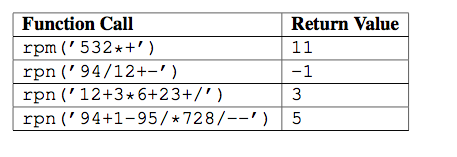Question
Reverse Polish Notation (RPN), also known as postfix notation, is an alternate way to represent a sequence of arithmetic operations. In RPN, we write the
Reverse Polish Notation (RPN), also known as postfix notation, is an alternate way to represent a sequence of arithmetic operations. In RPN, we write the operands/values first, followed by the applicable arithmetic operator (for example, 5 + 2 would be written as 52+). To evaluate a postfix/RPN expression, we record (save) operands until we reach an operator. Once we see an operator, we apply it to the last two operands we saw (in the appropriate order) and then record the result while we continue scanning for operands and operators. When we are done, we should have exactly one recorded value left, which will be our final answer.
For example, consider the expression 43*5 (assume that each operand is initially one digit in length). We begin by storing 4 and 3. When we encounter the multiplication operator, we multiply our last two stored values (4 and 3) and record the result (12). We record the next operand (5). Finally, we encounter the subtraction operator, so we perform 125 from our stored values to get the final answer of 7. Here is how the list would evolve over time:
[] [4] [4, 3] And then we see * in the argument string. Compute 4 * 3. [12] [12, 5] And then we see - in the argument string. Compute 12 - 5. [7]
In Python, we can perform this calculation using a list. Each time we read an operand, we use append() to add it to the end of our (initially empty) list. Each time we read an operator, we use pop() to remove and store the last two elements of the list in temporary variables. We apply the operator, and then append the result to the end of the list. When we are done, if the list contains exactly one value, that value is our final answer. If it does not, then there must have been an error in the original input value.
Complete the rpn() function, which takes a string representing an RPN expression (with single-digit operands) as its only argument. The function returns the numerical value of the original expression (as an integer). You may assume that the input string is properly formatted.
Note: Since we are working exclusively with integer values for this problem, interpret any division operators as performing floor (integer) division. Thus 83/ would evaluate to 2, not 2.67.
Examples:

def rpn(expression): return None
if __name__ == "__main__":
print('Testing rpn() for "532*+": ' + str(rpn('532*+'))) print('Testing rpn() for "94/12+-": ' + str(rpn('94/12+-'))) print('Testing rpn() for "12+3*6+23+/": ' + str(rpn('12+3*6+23+/'))) print('Testing rpn() for "94+1-95/*728/--": ' + str(rpn('94+1-95/*728/--'))) Function Call Return Value rpm (7532* 11 rpn 94/12 rpon 12+ 3* 6+23+ rpna ('94+1-95 *728/ S Step by Step Solution
There are 3 Steps involved in it
Step: 1

Get Instant Access to Expert-Tailored Solutions
See step-by-step solutions with expert insights and AI powered tools for academic success
Step: 2

Step: 3

Ace Your Homework with AI
Get the answers you need in no time with our AI-driven, step-by-step assistance
Get Started


